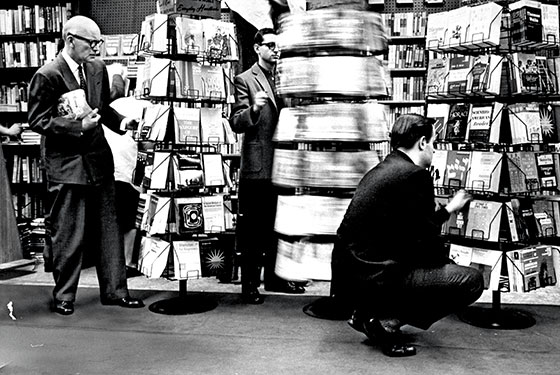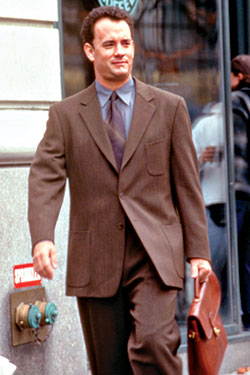
In the few weeks since Barnes & Noble announced the resignation of CEO William Lynch on the heels of huge losses in its digital division, the media coverage has ranged from alarm bells to death knells, but most of it has been strikingly elegiac for a company so recently reviled as a monopolizing monster. I’ve reported on the chain and shopped there, too, but I also had a somewhat more personal history with the store. Nineteen years ago, Barnes & Noble gave me my first over-the-table paycheck. The ensuing decades saw the rise and decline of a juggernaut—and a close lesson in the ironies of capitalism.
That summer job, in 1994, gave me an oddly quaint sense of a company that already ran more than 200 superstores. I worked in the old flagship Fifth Avenue branch, established in 1932. Across the street from a grungy soggy-bagel diner long since replaced by a Gap, the old store evoked both the chain’s prehistory and that of its CEO Leonard Riggio. A prizefighter’s son raised in Bensonhurst, Riggio started out as a clerk at the NYU bookstore before opening up a campus store of his own, and then a few more, serving sixties activists who sometimes printed fliers in the store basement.
The flagship was just a mismanaged remnant of a century-old bookseller when Riggio bought it in 1971. He immediately co-opted its staid, Waspy name for his growing stable. In the go-go eighties, the ex-hippie arriviste drew on leveraged investors to develop and expand the multitiered, stippled-green behemoths we know today.
In 1993, the company went public and added its first in-house Starbucks, inaugurating the era of mass-class suburban emporia. Fueled by debt-driven growth and deep discounts (much like its future usurper, Amazon), B&N accelerated its expansion, opening its 500th superstore in 1998. That year, the American Booksellers Association, representing 3,300 independent stores (a third fewer than just four years earlier), sued B&N and its chief rival, Borders, for bullying publishers into special deals. The rest of the industry was more private and selective in its complaints—especially over the chain’s onerous “co-op” fees, a pay-for-display policy that publishers termed “blackmail” and “whorehouse work.” As an agent once put it to me, “You feel raped having to pay for placement in a store you’re selling to.”
The broader public kept shopping but quickly got hip to the mom-and-pop-killer meme, thanks in part to the film You’ve Got Mail, Nora Ephron’s 1998 meet-cute between a superstore owner and a New York shopkeeper he was putting out of business. The Godzilla story was so pervasive that even Amazon’s Jeff Bezos, already a billionaire, got away with playing the underdog. “Goliath,” he said, “is always in range of a good slingshot.”
Bezos’s slingshot turned out to be the Kindle, helped along by the Great Recession. B&N store closings started outpacing openings after 2008, and Riggio’s Goliath lost two thirds of its value in four years. The explosive growth of e-books pushed Barnes & Noble to double down on the fledgling Nook, promoting Lynch—whose only experience was in e-commerce—to CEO in 2010. The plan backfired miserably, and now Lynch is gone, replaced by no CEO at all, while the company undergoes what Riggio calls “the process of reviewing its current plan.”
The industry that looked on Barnes & Noble as a virus now treats Amazon like a pandemic. Just last week, in advance of Obama’s visit to an Amazon warehouse, a letter from the ABA (now down to roughly 1,500 members) called Obama’s praise of the company “woefully misguided.” Publishers, meanwhile, are a lot more open in their disdain for Bezos than they ever were for Riggio—especially after Amazon came out on top in a recent antitrust suit over e-book prices. Now they’re on the side of Barnes & Noble, the last bastion of bricks and mortar. When Microsoft invested in the Nook last year, publishing CEOs wrote in to congratulate Lynch.
But that cooing sound you hear from publishers isn’t love for Barnes & Noble; it’s fear of its disappearance. Last year, one executive compared a B&N-free landscape to The Road: “The postapocalyptic world of publishing, with publishers pushing shopping carts down Broadway.” For all the anti-chain agitation, publishers long ago adapted to a world in which one business controls 25 percent of the market. And while it may have hastened publishing’s own rapid consolidation—culminating in this year’s Penguin–Random House merger—Barnes & Noble never seriously jeopardized the publisher’s role as the supplier. Amazon, though, is now a growing publisher in its own right, threatening to make not just bookstores but traditional publishers obsolete.
Still, B&N remains a monster, if a flailing one, as I learned when I had a second, far more nerve-racking encounter with the company. Several months before the release this week of my first book, Barnes & Noble’s contract with my publisher, Simon & Schuster, expired, and B&N began demanding new fees. After S&S balked, the chain responded by taking only token orders on many of Simon’s non-blockbusters. For mid-list authors, Barnes & Noble often ordered just a few dozen copies. (Last week, S&S CEO Carolyn Reidy reported “great progress” in the negotiations.)

“Believe me, if I had wanted to model it after you, I would have cast John Travolta instead of Tom Hanks,” Nora Ephron told Len Riggio, who she claimed was not the inspiration for the superstore owner in You’ve Got Mail.Photo: Everett Collection
The initial order on my book was bleak—less than 100 books for more than 600 stores—but improved, ironically, after the ABA touted the title. In the nail-biting interim, I came to appreciate what a sour marriage we’ve all come to have: Barnes & Noble muscled into the market by courting consumer love, wielding cheap books, lattes, and acres of space. Then, one day, we (writers, publishers, and readers) woke up to find we had no other options.
In this scenario, isn’t Amazon the dashing new lover without strings attached? No pay-for-display, no book returns, no messy printing presses? Not quite. A recent study from the Codex Group showed that while 60 percent of book sales have migrated online, books are only discovered online less than 20 percent of the time. That means that physical bookstores still matter, even to Jeff Bezos. In defeating its competitors, Amazon might be, as Evan Hughes puts it in Salon, “choking off some of its own air supply.”
But Bezos owes more than that to Barnes & Noble. In truth, he’s replicating the chain’s earlier life cycle. First, make yourself irresistible, then make yourself indispensable. Corner the market, and you’ll be too big to challenge. That’s exactly the scenario publishers worried about when they arranged to pressure Amazon to raise its e-book prices. The Justice Department deemed the publishers’ efforts collusion.
The other defendant in the government’s suit was Apple, whose scheming with publishers took place in preparation for the launch of its iBookstore. Apple testified in court that its three-year-old book program already controls 20 percent of the e-book market. Bezos never had Riggio’s bookish pretensions, but he did start out as a bookseller of a sort. Steve Jobs never did. Could the book world one day wax nostalgic for the Amazon era? It’s one of the few things in the book business you can count on.
Have good intel? Send tips to intel@nymag.com.
